CCNA – Drag and Drop 3
Here you will find answers to CCNA Drag and Drop Questions – Part 3
Question 1
Drag the security features on the left to the specific security risks they help protect against on the right. (Not all options are used)
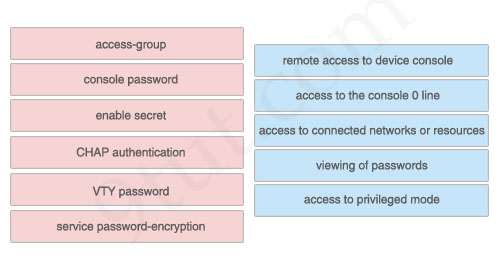
Answer:
1) VTY password: remote access to device console
2) console password: access to the console 0 line
3) access-group: access to connected networks or resources
4) service password-encryption: viewing of passwords
5) enable secret: access to privileged mode
The unselected left-box – CHAP – is used to verify the identity of the peer by means of a three-way handshake.
Question 2
Refer to the exhibit. PC-A is sending packets to the FTP server. Consider the packets as they leave RA interface Fa0/0 forwards RB. Drag the correct frame and packet address to their places in the table.
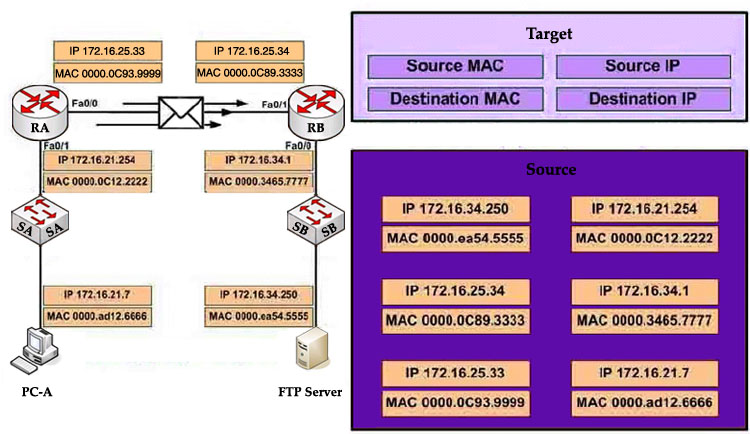
Answer:
Source MAC: 0000.0C93.9999
Destination MAC: 0000.0C89.3333
Source IP: 172.16.21.7
Destination IP: 172.16.34.250
Explanation
Remember these rules:
The IP addresses (of source and destination) of a packet never change during the transportation through the network. For example if PC-A wants to send a packet to PC-Z then the source and destination IP addresses of the packet will be the IP addresses of PC-A and PC-Z no matter how many devices they go through.
The MAC addresses, conversely, will change while passing the devices. The source MAC address is the address of the last sender and the destination MAC address is the address of the next device.
Question 3
As a network administrator, you are required to configure the network security policy. And the policy requires that only one host be permitted to attach dynamically to each switch interface. If that policy is violated, the interface should shut down. Which two commands must the network administrator configure on the 2950 Catalyst switch to meet this policy? Please choose appropriate commands and drag the items to the proper locations.
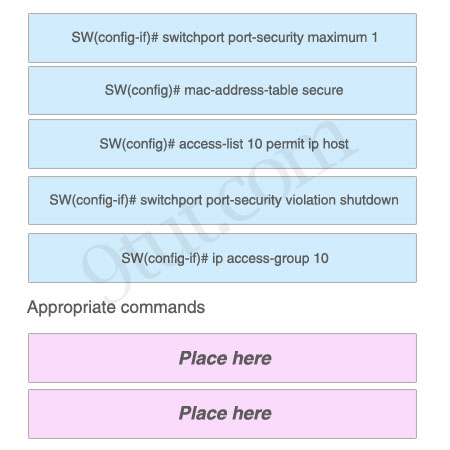
Answer:
Appropriate commands:
SW(config-if)# switchport port-security maximum 1
SW(config-if)# switchport port-security violation shutdown
Question 4
The left describes boot sequence, while the right describes the orders. Drag the items on the left to the proper locations.
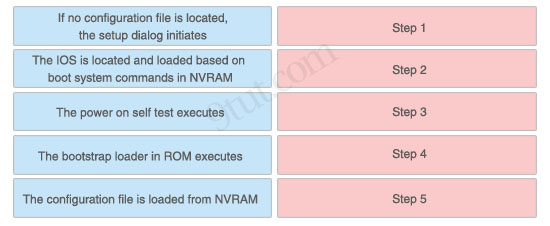
Answer:
1) Step 1: The power on self test executes.
2) Step 2: The bootstrap loader in ROM executes.
3) Step 3: The IOS is located and loaded based on boot system commands in NVRAM.
4) Step 4: The configuration file is loaded from NVRAM.
5) Step 5: If no configuration file is located, the setup dialog initiates.
Explanation
When a router boots up, it performs a series of steps, called the boot sequence, to test the hardware and load the necessary software. The boot sequence consists of the following steps:
1) Power on self test (POST): tests the hardware to verify that all components of the device are operational and present.
2) The bootstrap loader in ROM executes: The bootstrap loader is a program in ROM that is used to find where a valid Cisco IOS image is located.
3) If a valid Cisco IOS image is located, it is loaded.
4) IOS loads configuration file. Once the IOS image is loaded, it will search for a valid startup configuration in NVRAM.
5) If a valid startup configuration file cannot be found, the router will load the System Configuration Dialog (sometimes called setup mode). This mode allows you to perform the initial configuration of the router.
Question 5
Drag and Drop question. Drag the items to the proper locations.
Routing has been configured on the local router with these commands:
Local(config)# ip route 0.0.0.0 0.0.0.0 192.168.1.1
Local(config)# ip route 10.1.0.0 255.255.255.0 192.168.2.2
Local(config)# ip route 10.1.0.0 255.255.0.0 192.168.3.3
Drag each destination IP address on the top to its correct next hop address at the bottom.
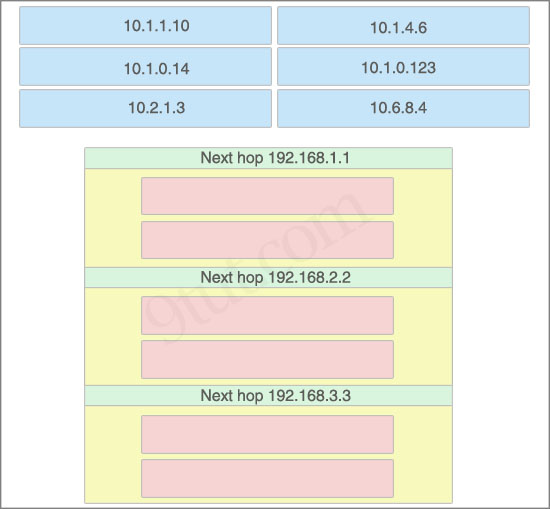
Answer:
Next hop 192.168.1.1:
+ 10.2.1.3
+ 10.6.8.4
Next hop 192.168.2.2:
+ 10.1.0.14
+ 10.1.0.123
Next hop 192.168.3.3:
+ 10.1.1.10
+ 10.1.4.6
Explanation
If we have many entries matching for next hop ip address then the router will choose the one with most specific path to send the packet. This is called the “longest match” rule, the route with the most bits in the mask set to “1″ will be chosen to route packet.
For example, the destination IP address of 10.1.1.10 will match two “ip route” commands:
ip route 10.1.0.0 255.255.255.0 192.168.2.2
ip route 10.1.0.0 255.255.0.0 192.168.3.3
But the first command is more specific (10.1.0.0/24 is more specific than 10.1.0.0/16) so the packet will be routed to 192.168.2.2.
Question 6
If a Cisco router has learned about network 10.1.1.0 from multiple sources, the router will select and install only one entry into the routing table. Indicate the order of preference that the router will use by dragging the routes on the left to the order of preference category on the right.
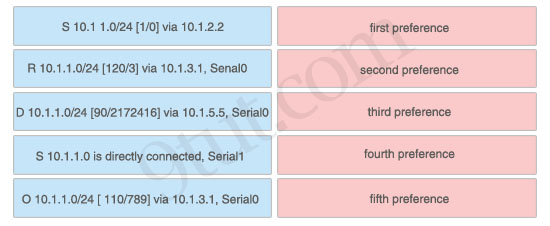
Answer:
1) First preference: S 10.1.1.0 is directly connected, Serial1
2) Second preference: S 10.1 1.0/24 [1/0] via 10.1.2.2
3) Third preference: D 10.1.1.0/24 [90/2172416] via 10.1.5.5, Serial0
4) Fourth preference: O 10.1.1.0/24 [ 110/789] via 10.1.3.1, Serial0
5) Fifth preference: R 10.1.1.0/24 [120/3] via 10.1.3.1, Senal0
Explanation
Administrative distance is the first criterion that a router uses to determine which routing protocol to use if two protocols provide route information for the same destination. It is a measure of the trustworthiness of the source of the routing information. The smaller the administrative distance value, the more reliable the protocol.
In this question, notice that the destination of all routes is 10.1.1.0/24 so we need to use Administrative distance of each routing protocol to specify the priority of each route. Below lists the Administrative Distance default values of popular routing protocols:
+ Directly connected: 0
+ Static route: 1
+ EIGRP (symbolize by “D”): 90
+ OSPF (symbolize by “O”): 110
+ RIP (symbolize by “R”): 120



q.5 there for my todays xam
Hi 9tut… Hi Guys! Can you please help me… I will take exam this Feb. Please send me latest dump so that I will have an idea for the exam.. rico.blake@ymail.com
Thanks Guys!
CCNA was not easy but thx to 9tut and Odom ICND1/ICND2, I was able to clear. Used Lammle (Sybex) yrs ago and very helpful so I’m pretty sure new version is good too. The examcollection.com Q’s are good practice but don’t depend on it… learn concepts and study hard! 48Q’s, VTP/ACL2 (don’t forget to go to host and check connect)/EIGRP (AS 2, check all routers config). Save your configs! 9tut is a great resource, study all! All the best to those preparing for test and congrats to those who have passed!
@ Z
pls could you help me with the dumps you used for the exams
pls my email yoshman19@yahoo.com
thanks
Hi ochoCinco,
yes, it is my openion too. 9tut. is very sincear, helpful and great site for whom , who study networking.
Many Thanks 9tut.
His i would like to know the maximum number of sims in the real exam
I got 3 SIMS ACL , VTP & EIGRP.
Q5 in exam. Hooray 9tut.
About to take the exam…Can someone send me the latest dumps wickedclown0813@gmail.com
Q5-i think this Q is not hard to get it right u c 10.1.0.0 and mask 255.255.255.0 easly think at any ’1′ bit as march and ’0′bit do’t care. so first three octets march and last octet doesn’t. but at same time 255.255.0.0 only the first 2 octets march so which one will take it???
Q5-i think this Q is not hard to get it right u c 10.1.0.0 and mask 255.255.255.0 easly think at any ’1′ bit as march and ’0′bit do’t care. so first three octets march and last octet doesn’t. but at same time 255.255.0.0 only the first 2 octets march so which one will take it??? THE ONE WITH MORE ’1′ BIT. /24 INSTEAD OF /16. ALSO MASK 0.0.0.0 ALWAYS TAKES WHAT IS LEFT BECAUSE IT HAS NO ’1′ BIS AT ALL.>NO PRIORITY TO TAKE FIRST OR SECOND.
I SAID IT AS THEY USE TO EXPLAIN ACL’S WILD-CARD.
I WISH THAT IT HELPS. ANY WAY.
Q2 was in my exam
q1, is it not supposed to be remote access to device virtual lines?
I am also taking CCNA 640-802 exam, Can anyone also send me latest test dump?
Best regards
mdshoheld007@yahoo.com
Q2 was in my exam today
Hi all, I am taking CCNA 640-802 exam first time on 30/05/2012. Could anyone please send me latest dumps which are valid for UK? My e-mail address is puneet_gill84@yahoo.co.uk. Many thanks.
Similar Q1 out in ICND2 today
I PASSED CCNA EXAM TODAY THANKS TO ALL MIGHTY ALLAH
960/1000
I passed my ccna exam today Praise be to God! Thank you Jesus! and thanks to 9TUT for the tutorials and explanations, great site and thanks to xallax for your explanations to questions and thanks to http://www.examcollection.com for the dumps. Pls guys lets donate and help to keep this site up!
48 ques for exams including 3 simulation, I had EIGRP, Acesslist2 and VTP and ques 2. Make sure you practice the simulation, use packet tracer or gns3. Best wishes to all!
9tut, xallax
CCNA DRAG AND DROP QUESTION:
ADVANTAGE AND DISADVANTAGE of POINT TO POINT, CIRCUIT SWITCHED and PACKET SWITCHED
bandwidth, quality, delay, more flexibility, low speed, more complex, load, cost, limited flexibility, efficient
Question 5.
So all we’re doing is finding the ranges for static routes? Change all zeros’s to 1′s and find the range.
DID IT!!…907…thx 9tut!!!!..CCNA certified….tons of questions from this site…read from top to bottom every question, because you will not know what pops up…q2…good luck to all…can’t stress enough…read EVERY question on this site…
question 5 appears in the latest exam
Some really interesting details you have written on http://www.9tut.com .Aided me a lot, just what I was searching for :D .
Q5. Wrong answer? I think the last 2 answers must be swapped. The IP addresses for .2.2 and .3.3 should be swapped.
@ Eugene i think Q5 is correct. looking at subnet mask u that the .2.2 has a subnet of 255.255.255.0 meaning the first 3 octed represent the subnet and most be the same that why 10.1.0.14 and 10.1.0.123 and the next is .3.3 which has a subnet mask of 255.255.0.0 which is a /16 network meaning the first two octed are for the subnet. that why 10.1.1.10 and 10.1.4.6. check the subnet mask and thier addresses.
thanks
@Sniffer.
Thanks. I get it now.
Please Can any one teach me how to solve Q.5 , I am finding hard with subnets so please solve it in nice way so I can understand !
Thanks in advance
You have to follow the match rule…
Ok lets look at
Local(config)# ip route 0.0.0.0 0.0.0.0 192.168.1.1
Local(config)# ip route 10.1.0.0 255.255.255.0 192.168.2.2
Local(config)# ip route 10.1.0.0 255.255.0.0 192.168.3.3
If you notice in the last one for 10.1.0.0 the subnet mask is 255.255.0.0 which means the change is in the third octect. So IP Addresses with 10.1.x.0 will follow this route.
Look at the root for 10.1.0.0. Its subnet mask is 255.255.255.0. The change is in the fourth octect. So the choices with 10.1.0.x will follow this route. All other IPs will follow the default route of 0.0.0.0 0.0.0.0 which means all others that do no match. I hope this explained it well for you.
q5 :
Nov 1, 2007 12:14 PM (in response to Johnramz@gmail.com)
Re: Static IP routes question
You’re making me think, and I haven’t had enough caffeine yet. :)
Ok, so let’s rewrite these in most specific order…
R1(config)#ip route 10.1.0.0 255.255.255.0 192.168.2.2
This covers from 10.1.0.0 to 10.1.0.255, so 10.1.0.123 would fall in here.
R1(config)#ip route 10.1.0.0 255.255.0.0 192.168.3.3
This covers from 10.1.0.0 to 10.1.255.255, so:
10.1.1.10
10.1.1.14
10.1.4.6
10.1.0.123
would fall in here, but we already routed 10.1.0.123 because the most-specific route always wins.
R1(config)#ip route 0.0.0.0 0.0.0.0 192.168.1.1
would cover anything else not listed, which include:
10.2.1.3
10.6.8.4
So the answer they provided is incorrect because 10.1.1.14 would NOT be routed to 192.168.2.2…
On the other hand, while you are numerically correct in your answer (192.168.3.3 COULD accept 10.1.0.123), the router would choose the most-specific route and therefore make 192.168.2.2 the correct next hop for it.
I know all these things a router thinks about can certainly be a pain to step through and learn!
HTH,
@9tut
give the explanation for Q5..
9tut or anyone that is able to answer my question, could you please explain why the source MAC is the first router and the destination MAC being the next router instead of the FTP server? There does not seem to be any consistency with these types of question regarding how packet moves from point A to point B. Could someone please break it down to me? Thanks
By the way, my question above is referring to Q2.
@Jamerican: It is difficult to explain in a simple way. That is how networking devices work. In general, packets always have 2 addresses: One permanently and one temporarily. For example, if you want to send a mail to your friend you have to know 2 addresses: The address of your friend (permanent IP address) and the address of your local post office (temporary MAC address). While your mail is transferred to middle countries, your friend’s address is not changed but the post office’s address of that country is changed.
TY 9tut.
Today I have passed the CCNA. (860/825)
50 questions 3 labs (VTP, EIGRP, ACL). 35 from 9tut.
Also thanks a lot Brar and Sekhar (still valid from examcollection)
Ty again 9tut
from here none
Can someone please send the Brar and Sekhar (still valid from examcollection) to email address icnd2ineed@gmail.com
thx so much
q2:
I had this question today… see page 354 of Sybex CCNA Study Guide T. Lammle.
Quote:
“The dest address of a frame, from host A, will be the MAC of Fa0/0 of int of router A”
so dest MAC:
the .2222
making the source MAC:
the .7777
I like this site, but you gotta make sure the answers are correct..
I am giving ccna exam next month,will this be valid for that time,plz plz tell me
Plss
Can some one send me Prepking 680Q? to arulsr2@gmail.com
I have a MacBook computer and I want my pictures that are on my computer to be on my Motorola Razr 2 v9. I have a memory card and a memory card adapter. When I put the card in the adapter, the computer recognizes it. And the pictures that I have on my phone can transfer to the computer with no problem. But the pictures on my computer won’t transfer to my phone. All that shows up is a big red “x” on a black screen. Am I doing something wrong? The phone company is AT&T..
Q.1 on ICND2 test
giving ccna exam next month plz give me leatst dump its my id azamriaz@live.com
Valid Que :D
Q:2
Q:6
HI
I’ll take the exam in 2 weeks so I need the latest dumps. Please send me those dumps on my email: woogie.boogie@ymail.com.
Thank you
Please can some body send me the latest dumps to my email:stevemathew654@gmail.com.
I have CCNA exam 3rd of February 2013 please please
Oh my bad, mistake please can somebody send me the latest dumps i have my CCNA exam 2nd week of April 2013 please please
Aw, this was a really nice post. In thought I want to put in writing like this additionally ? taking time and precise effort to make a very good article? however what can I say? I procrastinate alot and not at all seem to get one thing done.
I did not really understand question 5. Can someone please explain it further
@Q-6
EIGRP is Symbolized by “D”, Then What About Directly Connected..??
IS the Order you selected is right…?? There is written S and Directly Connected as well that’s Ok but the 2nd preference is oK or Not..??
Clear Please
I had my ccna yesterday the 25 of february 2013, though i was dissapointed with my score(841). all my thanks goes first and fore most to my GOD who made me who i am today. to my School and its director and friends too. determination is the key.
ABOUT MY EXAM : what killed me was fear which should be discouraged. i had 3 sims that is, vtp, eigrp, acl2. thesame as in 9tut.
special thanks goes to this famous site.